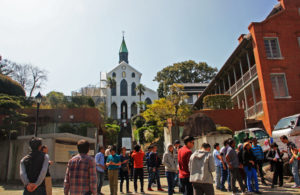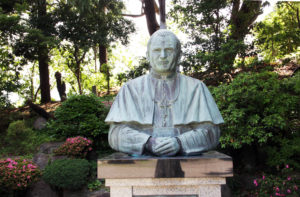Urakami Cathedral, in Nagasaki
Construction of the original Urakami Cathedral, a brick Romanesque building, began in 1895,
after a long-standing ban on Christianity was lifted.
When completed in 1914, it was the largest Catholic church in East Asia.
 |
|
|
The Atomic bomb dropped on August 9, 1945 explored in Urakami, only 500m from the cathedral,
which was completely destroyed.
What remained of the cathedral is now on display in the Atomic Bomb Museum.
A replacement was built in 1959, and remodeled to more closely resemble the original in 1980.
The nearby the Ground Zero in Peace Park contains remnants of the Ruins of Urakami Cathedral
 |
 |
 |
Oura Cathedral, in Nagasaki
The Cathedral is one of the significant Christian Pilgrimage site in Japan. Established 1865,
this church is officially known as “Oura Cathedral, the Church of 26 Martyrs.” It was built by
the French priest Bernard Petitjean of Fier who had been dispatched by the Foreign
Missionary Church of Paris to dedicate prayers to the 26 saints martyred on Nishizaka hill.
For this reason, the church faces Nishizaka hill. It was designated as a National Treasure in
1933 for its value as Japan’s oldest Gothic-style Cathedral.
|
|
|
|
“On March 17, 1865, a group of peasants from Urakami came to the church and professed
their faith to Father Petitjean, thus revealing that Christianity had survived through the
centuries of persecution. The white marble statue of the Holy Mother at the entrance was built
in commemoration of the dramatic discovery of the “Hidden Christians.
|
|
|
|
Nakamachi Church, in Nagasaki
Nakamachi Church is located near JR Nagasaki Station which was constructed
for Japanese Christians in 1986.
The church was dedicated to the 16 Saints of Nagasaki (St. Thomas and the 15 Martyrs)
in 1988, and the monument honoring them was erected in the premise.
The 16 Saints were martyred in Nagasaki from 1633 to 1637.
 |
 |
 |
The 16 martyrs became Saints in 1987, since 26 Saint.
Dominic Ibáñez de Erquicia Pérez de Lete, Spanish, 1633, Dominican Priest
Antonio Gonzalez, Spanish, 1637, Dominican Priest
Jordan Ansalone, Italian, 1634, Dominican Priest
Luke of the Holy Spirit Alonso Gorda, Spanish, 1633, Dominican Priest
Michael de Aozaraza, Spanish, 1637, Dominican Priest
Guillaume Courtet, French, 1637, Dominican Priest
Jacobo Kyushei Gorōbyōe Tomonaga de Santa María, Japanese, 1633, Dominican Priest
Thomas Rokuzayemon Nishi, Japanese, 1634, Dominican Priest
Vincent Shiwozuka, Japanese, 1637, Dominican Priest
Francis Shōyemon, Japanese, 1633
Matthew Kohioye, Japanese, 1633
Lorenzo Ruiz, Filipino, 1637
Marina of Omura, Japanese, 1634
Magdalene of Nagasaki, Japanese, 1634
Michael Kurobioye, Japanese, 1633
Lazarus of Kyoto, Japanese, 1637
Saint Kolbe Memorial Museum, at Hongouchi Church, in Nagasaki
Father Maximilian Kolbe was born in Poland in 1894 and was a priest of the Conventual
Order of St. Francis.
He had been active in promoting the veneration of the Immaculate Virgin Mary.
He came to Japan in 1930 and began educating seminarians and publishing a monthly
magazine ” the veneration of the Immaculate Virgin Mary.”
After that, the number of Japanese people who understood God’s teachings increased,
and Hongouchi Church was established in 1931.
 |
 |
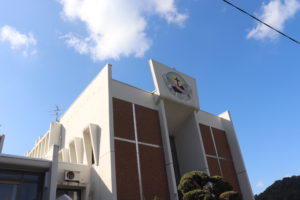 |
After six years in Japan, he returned to Poland for health reasons.
And then, he volunteered to die in place of a man named Franciszek Gajowniczek in the
German death camp of Auschwitz, located in German-occupied Poland.
Saint Kolbe Memorial Museum was built to commemorate his canonization in 1986.
Saint Filippo de Jesus Church ( Japan 26 Saints Memorial Church ), in Nagasaki
This is a church with Gaudi-style twin tower designed by Kenjiro Imai,
built next to the Nishizaka Martyrdom site
 |
 |
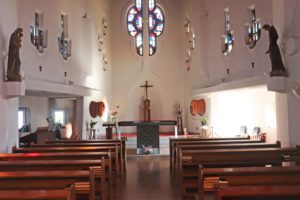 |
When there was a plan to build a memorial hall for the 26 Japanese Saints
next to Nishizaka Martyrdon site, a large donation was made from Mexico,
and the Church was built in 1962.
This church is dedicated to Mexican Filippo de Jesus, who is one of the 26 Saints.
Filippo de Jesus was a Franciscan Catholic missionary who became one of the
26 Martyrs of Japan, the first Mexican Saint.
Shimabara Peninsula Martyrs Memorial Cathedral, in Shimabara
This Cathedral is house of prayer for tens of thousands Christians who were martyred
between 1612 and 1658 throughout the Shimabara Peninsula.
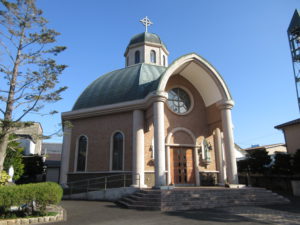 |
 |
 |
It was built in 1997 to commemorate the 400th anniversary of the martyrdom of 26
Japanese Saints and the 360th anniversary of the Shimabara Rebellion.
The Cathedral is a beautiful octagonal building with a large octagonal dome.
Nagasaki was a small Rome in 1569
Todos os Santos Church, the first church in Nagasaki, was built in 1569.
Federal lord Omura and the Jesuits made an agreement to make Nagasaki
a port for trade with Nanban. (Portugal and Spain) in 1570.
Nagasaki Port was opened and the first Portuguese ship arrived in 1571.
And development of the town of cape was started as Christian town in 1571
and the small Church of San Paulo was constructed at the tip of cape.
 |
 |
 |
After that following Churches were constructed.
Misericordia Headquarters Church in 1583
Santa Maria Church in 1600
Santa Clara Church in 1603
Santiago Church in 1604
San Juan Petista Church in 1605
San Antonio Church in 1606
San Pedro Church in 1607
San Francisco Church in 1611
San Agustin Church in 1612
For 45 years after the first church was built, Nagasaki developed as a Christian town,
and by 1614, most of the 25,000 people were Christians.
It was as if Nagasaki was a small Rome.
However, due to the Tokugawa Shogunate’s Ban on Christianity in 1614, most of the
church buildings were destroyed within 15 days from November 3rd.



